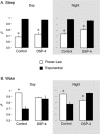Developmental emergence of power-law wake behavior depends upon the functional integrity of the locus coeruleus
- PMID: 19639755
- PMCID: PMC2706896
- DOI: 10.1093/sleep/32.7.920
Developmental emergence of power-law wake behavior depends upon the functional integrity of the locus coeruleus
Abstract
Study objectives: Daily amounts of sleep and wakefulness are accumulated in discrete bouts that exhibit distinct statistical properties. In adult mammals, sleep bout durations follow an exponential distribution whereas wake bout durations follow a power-law distribution. In infant Norway rats, however, wake bouts initially follow an exponential distribution and only transition to a power-law distribution beginning around postnatal day 15 (P15). Here we test the hypothesis that the locus coeruleus (LC), one of several wake-active nuclei in the brainstem, contributes to this developmental transition.
Design: At P7, rats were injected subcutaneously with saline or DSP-4, a neurotoxin that targets noradrenergic (NA) LC terminals. Then, at P21, sleep and wakefulness during the day and night were monitored. The effectiveness of DSP-4 treatment was verified by measuring NA, dopamine (DA), and serotonin (5-HT) concentration in cortical and non-cortical tissue using high performance liquid chromatography.
Results: In relation to controls, subjects treated with DSP-4 exhibited significant reductions only in cortical and non-cortical NA concentration. Consistent with our hypothesis, the wake bout durations of DSP-4 subjects more closely followed an exponential distribution, whereas those of control subjects followed the expected power-law distribution. Sleep bout distributions were unaffected by DSP-4.
Conclusions: These results suggest that the fundamental developmental transition in the statistical structure of wake bout durations is effected in part by changes in noradrenergic LC functioning. Considered within the domain of network theory, the hub-like connectivity of the LC may have important implications for the maintenance of network function in the face of random or targeted neural degeneration.
Figures


Similar articles
-
Role of the locus coeruleus in the emergence of power law wake bouts in a model of the brainstem sleep-wake system through early infancy.J Theor Biol. 2017 Aug 7;426:82-95. doi: 10.1016/j.jtbi.2017.05.027. Epub 2017 May 25. J Theor Biol. 2017. PMID: 28552556
-
Circadian regulation of arousal: role of the noradrenergic locus coeruleus system and light exposure.Sleep. 2006 Oct;29(10):1327-36. doi: 10.1093/sleep/29.10.1327. Sleep. 2006. PMID: 17068987
-
Dynamics of sleep-wake cyclicity in developing rats.Proc Natl Acad Sci U S A. 2005 Oct 11;102(41):14860-4. doi: 10.1073/pnas.0506340102. Epub 2005 Sep 28. Proc Natl Acad Sci U S A. 2005. PMID: 16192355 Free PMC article.
-
Selective effects of DSP-4 on locus coeruleus axons: are there pharmacologically different types of noradrenergic axons in the central nervous system?Prog Brain Res. 1991;88:257-68. doi: 10.1016/s0079-6123(08)63815-7. Prog Brain Res. 1991. PMID: 1726027 Review.
-
Brainstem neural mechanisms of sleep and wakefulness.Eur Urol. 1998;33 Suppl 3:12-5. doi: 10.1159/000052235. Eur Urol. 1998. PMID: 9599730 Review.
Cited by
-
Development of the sleep-wake switch in rats during the P2-P21 early infancy period.Front Netw Physiol. 2024 Jan 4;3:1340722. doi: 10.3389/fnetp.2023.1340722. eCollection 2023. Front Netw Physiol. 2024. PMID: 38239232 Free PMC article.
-
Dopamine modulates the rest period length without perturbation of its power law distribution in Drosophila melanogaster.PLoS One. 2012;7(2):e32007. doi: 10.1371/journal.pone.0032007. Epub 2012 Feb 16. PLoS One. 2012. PMID: 22359653 Free PMC article.
-
The development of sleep-wake rhythms and the search for elemental circuits in the infant brain.Behav Neurosci. 2014 Jun;128(3):250-63. doi: 10.1037/a0035891. Epub 2014 Apr 7. Behav Neurosci. 2014. PMID: 24708298 Free PMC article. Review.
-
Sleep-wake regulation in preterm and term infants.Sleep. 2021 Jan 21;44(1):zsaa148. doi: 10.1093/sleep/zsaa148. Sleep. 2021. PMID: 32770211 Free PMC article.
-
Switching mechanisms and bout times in a pair of reciprocally inhibitory neurons.J Comput Neurosci. 2014 Apr;36(2):177-91. doi: 10.1007/s10827-013-0464-6. Epub 2013 Jul 3. J Comput Neurosci. 2014. PMID: 23820857
References
Publication types
MeSH terms
Substances
Grants and funding
LinkOut - more resources
Full Text Sources
Miscellaneous

